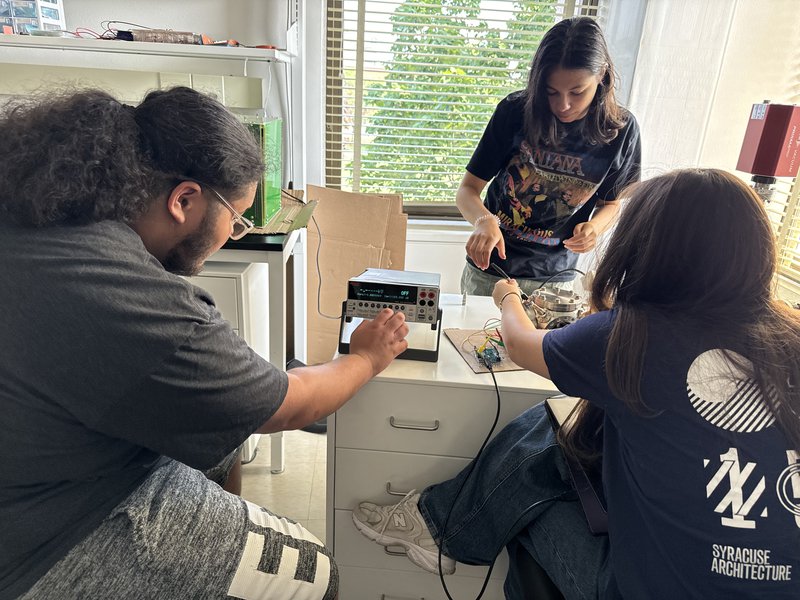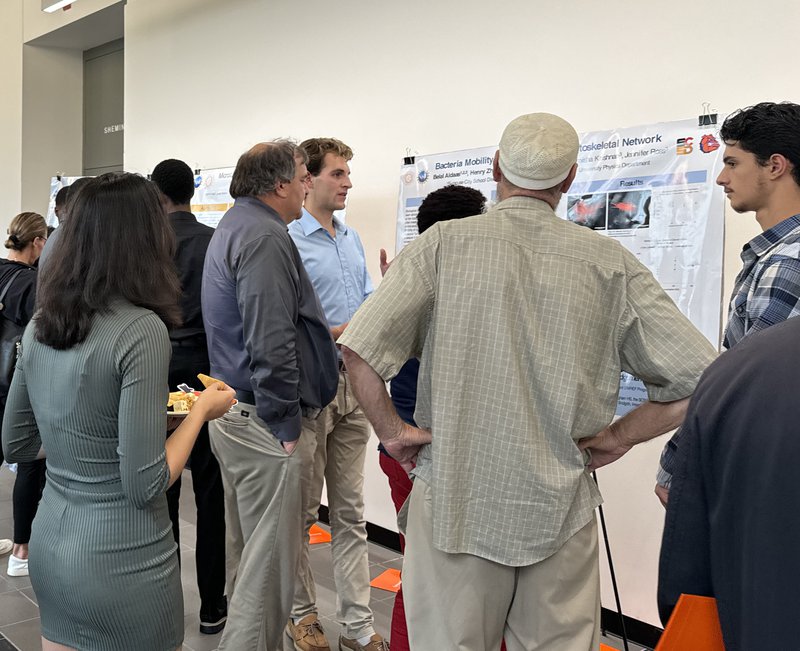Creating STEM Career Pathways for Local High Schoolers
Thanks to a new National Science Foundation grant, Syracuse University’s physics department doubles the number of Syracuse-area high school participants in their paid summer internship program.

The 2024 cohort of Syracuse-area high school students who took part in the Syracuse University Physics Emerging Research Technologies Summer High School Internship Program.
STEM jobs are quickly becoming the backbone of America. By 2031, STEM occupations are projected to grow by 10.8%, while non-STEM occupations will grow at about half that rate at 4.9%. Therefore, it’s essential for today’s students to gain a solid foundation in math, science and engineering subjects. Syracuse is about to see its own boom in STEM jobs, as the arrival of the Micron chip manufacturing facility will include 9,000 high-paying positions at their Central New York campus.
Federal funding organizations like the National Science Foundation (NSF) have acknowledged this workforce shift and are seeding and supporting initiatives aimed at growing a diverse STEM workforce. Since 2022, the College of Arts and Sciences’ Department of Physics has hosted one such program, bringing in Syracuse-area high school students to take part in a paid research internship. In support of that program, the NSF recently pledged nearly $1 million to Syracuse University through their Experiential Learning for Emerging and Novel Technologies (ExLENT) campaign, which will fund the physics internship over three years.

Originally known as Syracuse University Research in Physics (SURPh) during its first two summers in 2022 and 2023, the program seeks to create STEM career pathways for historically excluded groups by involving them in authentic research experiences and providing mentoring and peer networks. SURPh was the brainchild of former physics student Ruell Branch ’24, who pitched the idea to his professors as a way to strengthen the University’s connection with the local community and inspire local students to pursue STEM.
“I wanted Syracuse city high school students who have interests in physics to see what it's like to work as a paid scientist,” says Branch, who is also a graduate of the Syracuse City School District. “I think it’s extremely important for students to get experience conducting research in an actual science lab.”
Expanding the Program
With the help of physics professor Jennifer Ross, Henninger High School science teacher Melanie Pelcher, and fellow Syracuse alum and Henninger High School graduate Devon Lamanna, SURPh was born. Now, thanks to the NSF funding awarded to Ross and fellow physics professor and department chair Mitch Soderberg, the summer program will be funded through the summer of 2026.
“The new NSF support is a game-changer,” says Soderberg. “It signifies to the students who participate that not only those of us in the SU physics department and Syracuse city schools, but also policy makers in the federal government, see value in helping them get excited about STEM disciplines and see potential for them as future professionals who will someday help drive innovation and discovery.”
The three-year grant, totaling nearly $1 million, allowed the program to grow from 12 students in 2023 to 24 in 2024 and brought in additional faculty mentors. In past years, SURPh was made possible thanks to funding from the John Ben Snow Foundation and internal support from the Engaged Humanities Network and the physics department.
“This program could not have achieved NSF funding without these other sources to prop us up,” says Ross.
Now called the Syracuse University Physics Emerging Research Technologies Summer High School Internship Program (SUPER-Tech SHIP), the program just wrapped their summer session with a closing ceremony and poster session.
Through SUPER-Tech SHIP, students were exposed to skills and concepts related to computational physics, biophysics and particle physics during the six-week program.
2024 Research Groups
Computational Astrophysics
Faculty mentors: Eric Coughlin and Alex Nitz
These research groups were interested in understanding the physics behind some of the largest structures in our universe including black holes and stars. Using computational approaches, they simulated big events in the universe like colliding black holes and compared these events to the data from gravitational wave detectors.
Biophysics and Soft Matter Physics

Faculty mentors: Mirna Mihovilovic-Skanata, Alison Patteson, Jennifer Ross and Christian Santangelo
These groups worked on the soft side of physics - materials and objects which are often deformable and squishy. Ross and Patteson have been training high schoolers from the inception of the program in the physics underlying the molecular to cellular side of biology. Mihovilovic-Skanata examined animal behavior that stems from molecular reactions. Santangelo worked on non-living deformable materials to understand how things bend and break and how to control the bending and breaking.
Particle Physics
Faculty Mentors: Denver Whittington, Mitch Soderberg, Marina Artuso and Matt Rudolph
These groups studied the tiny particles inside atoms and flying across space. Whittington and Soderberg continued their work in the program training students in how to detect neutrinos – one of the most fundamental, abundant and lightest subatomic particles with mass. Artuso and Rudolph worked with students on fundamental particles called quarks. In their research, they build detectors that go into the large hadron collider at CERN, which is the world's largest and most powerful particle accelerator.

Students from the Whittington Group building a cosmic-ray detector.
Generating Interest from an Early Age
Physics, like with other sciences, can sometimes be perceived as being “too hard,” which can cause students to shy away from it, notes Ross. For this reason, she believes programs like SUPER-Tech SHIP, which spark students' interest in physics early on, are crucial for helping them persevere through challenging times.
“It does require hard work and dedication to learn the math and understand the basic approaches to solving physics problems, but a lot of physics is really creative – especially to discover new information at the cutting edge,” says Ross. “In research, students are learning that it isn’t about homework and tests, but about genuine trial and fail and retrying. Research requires ingenuity and perseverance, and it is a place where “failing” is important, as long as we learn from it.”
She and the other faculty mentors hope that the participants come away understanding that physics is fun, profitable and attainable. This is one of the major reasons the internship is paid - to encourage the students to take part in research rather than taking a typical summer job.
“Local kids often need to work in the summer and during the school year, so we wanted to ensure that this financial barrier was lowered to allow them the opportunity to get exposure to science,” says Ross.

Students from the Soderberg Group gained valuable hands-on experience working with detectors used in experimental particle physics research.
SCSD physics teacher Melanie Pelcher says another important facet of this year’s expanded program was the return of previous participants who now served as mentors to first-year students.
“Having a mentor who has experienced what it’s like to be both a new lab member and a part of the SCSD community is invaluable,” Pelcher notes. “This is not just a one-summer opportunity but a multi-year journey to learn, grow and remain an integral part of their research groups. This success wouldn’t be possible without the ongoing partnership between SU and the SCSD, both of which are dedicated to developing the future physicists in our ranks.”
Welcoming to All
As a University committed to experiential inquiry and learning by doing, as outlined in the Academic Strategic Plan, this initiative showcases a successful community partnership where local high school students collaborate with faculty through hands-on research to solve real-world problems.
“This program has quickly become something special to all of us involved, and really embodies our department’s mission to be a place that is welcoming to all,” says Soderberg. “Our department is extremely fortunate to have so many faculty and student members who are passionate not just about their research, but also about teaching and having an impact on their community.”

SCSD students presented their research projects during a poster session.
To ensure the program is meeting the needs of its participants, the physics department collects feedback before and after the internship thanks to a cross-college partnership with Michiko Ueda-Ballmer, associate professor in the Maxwell School’s Department of Public Administration and International Affairs. One of Ueda-Ballmer’s areas of expertise is program evaluation, so she conducts participant surveys to gain insights about their experience and the program's potential impact on their career trajectory and interest in STEM.
“Prior to the program, 54% of the participants had plans to pursue a post-undergraduate degree. After the program, 70% of them now plan to pursue a post-undergraduate degree, suggesting that the experience positively influenced their career plans,” says Ueda-Ballmer.
As the program wraps up another year, Ross hopes that the experience motivates at least some of the students to consider a future at Syracuse.
“My ultimate goal is for one of our local kids to decide on physics as a career, get their Ph.D. and come back to Syracuse University to teach for us. It might be a 1 in 100 chance, but if we can get 100 kids through this program, we will have a good shot to make that happen,” she says.
Going forward, the NSF funding will cover the program for at least two more years. In the meantime, the department is hoping to create an endowment to cover the costs of this program in perpetuity.
Featured
Jennifer Ross Interim Dean for the College of Engineering and Computer Science, Professor of Physics
Mitchell Soderberg Professor and Department Chair
